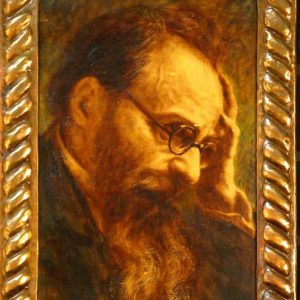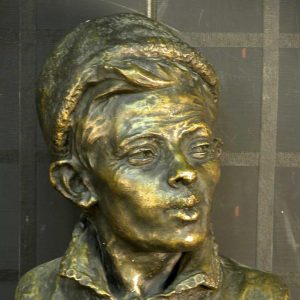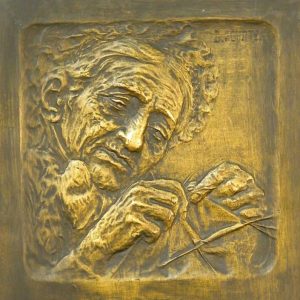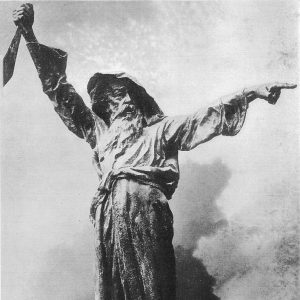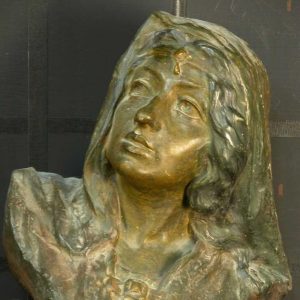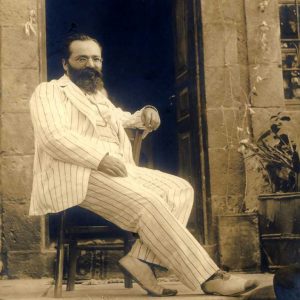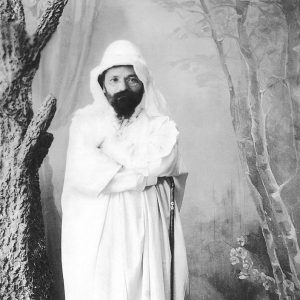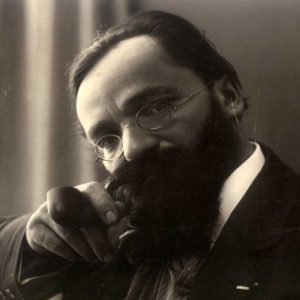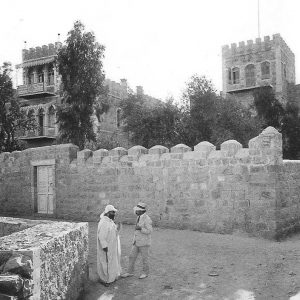


Boris Schatz (1866-1932)
The father of Israeli art. Founded the Bezalel academy of art, design and architecture in 1906, in Jerusalem, Israel.
"I looked upon art as a temple and upon artists as its priests. I dreamed that I should become a high priest in the service of sacred art, that I would teach mankind the ideal of the great and beautiful…" (Schatz 1910)
Shlomo – Zalman Dov Baruch was born in Lithuania in 1866 to a religious family with a rabbinical lineage. With his unique talents, he was meant to continue the family dynasty and was sent to Vilna to study in yeshiva (Talmudic college). But Boris was quizzical and had a desire for experience, and religious studies were not suitable for him. [From the autobiography: "…as much as I tried not to think about things that cause one to sin, they still crept into my mind… from that time on I began drawing and loving human portraits, in which I find also today the most interesting material for art…"]. He moved to Warsaw, where he began his life as an artist and created his first sculpture "Hendel," which perpetuates the Jewish peddler.
In 1889 he married Jennie, his first wife, and together they went to Paris. Schatz studied with the sculptor Mark Antokolski, and at the same time studied painting in the Cormorn Academy. He earned a living through random jobs and also engaged in boxing and wrestling. In 1894 he sculpted his famous sculpture "Mattithyahu HaHashmonai" and started gaining recognition as an artist.
Following Prince Ferdinand inviting him to be the court sculptor of the Bulgarian Kingdom, Boris transferred his residence to Bulgaria and founded the Royal Academy of Art in Sofia. After the move to Bulgaria, his marital life ended in divorce and separation from his wife Jennie and their daughter Angela. The disappointment from the dissolution of his marriage accelerated his uprooting from Bulgaria. In 1903 he met Binyamin Zeev Hertzel. He presented him with the idea of founding a Talmudic college for art-crafts, that would be called "Bezalel" after Bezalel Ben Uri Ben Hur, from the tribe of Yehuda (the first artist mentioned in the bible). The decision to found this establishment was accepted in the Seventh Zionist Congress in Basil.
In 1906 Boris Schatz arrived in Israel and founded "Bezalel," which began operating with a fabrics and carpets department. Departments for silver design, brass work, wicker furniture, lithographs and others were gradually added, 30 different handicrafts in total. At a certain point such a wide variety of artwork was made that they were displayed in exhibits, and a small museum was opened in the school. This museum became the basis for the Israel Museum.
In 1909 Boris Shatz began presenting "Bezalel" exhibits all over the world for commercial and publicity purposes in order to acquire supporters and donors who would buy the school's products and in that fashion contribute to its development. The school prospered, social life and artworks were created in it, as were ideas that served as a founding stone for the revival of a renewing Hebrew culture in Israel.
In 1911 Boris Schatz married Dr. Olga Pavzner, an art critic 15 years younger than him. A year later, their first son was born, Bezalel Schatz, and four years later, their daughter Zohara Schatz was born. The "Bezalel" school was closed down by the Turks for the first time during the First World War. Professor Schatz was arrested and deported, at first to Syria and then to Zephath.
With its reopening after the war, the school encountered extreme economic difficulties. Boris Schatz died in 1932 in Colorado, USA, while traveling to collect donations for Bezalel.
The Bezalel School went through many ups and downs throughout the last century since Schatz's days. The Bezalel Academy, in its current form, is a fruitful and active continuation of that important foundation which Boris Schatz laid, and is the leading institute for the study of art, design, and architecture in Israel.
Boris Schatz (1866-1932)
The father of Israeli art. Founded the Bezalel academy of art, design and architecture in 1906, in Jerusalem, Israel.
"I looked upon art as a temple and upon artists as its priests. I dreamed that I should become a high priest in the service of sacred art, that I would teach mankind the ideal of the great and beautiful…" (Schatz 1910)
Shlomo – Zalman Dov Baruch was born in Lithuania in 1866 to a religious family with a rabbinical lineage. With his unique talents, he was meant to continue the family dynasty and was sent to Vilna to study in yeshiva (Talmudic college). But Boris was quizzical and had a desire for experience, and religious studies were not suitable for him. [From the autobiography: "…as much as I tried not to think about things that cause one to sin, they still crept into my mind… from that time on I began drawing and loving human portraits, in which I find also today the most interesting material for art…"]. He moved to Warsaw, where he began his life as an artist and created his first sculpture "Hendel," which perpetuates the Jewish peddler.
In 1889 he married Jennie, his first wife, and together they went to Paris. Schatz studied with the sculptor Mark Antokolski, and at the same time studied painting in the Cormorn Academy. He earned a living through random jobs and also engaged in boxing and wrestling. In 1894 he sculpted his famous sculpture "Mattithyahu HaHashmonai" and started gaining recognition as an artist.
Following Prince Ferdinand inviting him to be the court sculptor of the Bulgarian Kingdom, Boris transferred his residence to Bulgaria and founded the Royal Academy of Art in Sofia. After the move to Bulgaria, his marital life ended in divorce and separation from his wife Jennie and their daughter Angela. The disappointment from the dissolution of his marriage accelerated his uprooting from Bulgaria. In 1903 he met Binyamin Zeev Hertzel. He presented him with the idea of founding a Talmudic college for art-crafts, that would be called "Bezalel" after Bezalel Ben Uri Ben Hur, from the tribe of Yehuda (the first artist mentioned in the bible). The decision to found this establishment was accepted in the Seventh Zionist Congress in Basil.
In 1906 Boris Schatz arrived in Israel and founded "Bezalel," which began operating with a fabrics and carpets department. Departments for silver design, brass work, wicker furniture, lithographs and others were gradually added, 30 different handicrafts in total. At a certain point such a wide variety of artwork was made that they were displayed in exhibits, and a small museum was opened in the school. This museum became the basis for the Israel Museum.
In 1909 Boris Shatz began presenting "Bezalel" exhibits all over the world for commercial and publicity purposes in order to acquire supporters and donors who would buy the school's products and in that fashion contribute to its development. The school prospered, social life and artworks were created in it, as were ideas that served as a founding stone for the revival of a renewing Hebrew culture in Israel.
In 1911 Boris Schatz married Dr. Olga Pavzner, an art critic 15 years younger than him. A year later, their first son was born, Bezalel Schatz, and four years later, their daughter Zohara Schatz was born. The "Bezalel" school was closed down by the Turks for the first time during the First World War. Professor Schatz was arrested and deported, at first to Syria and then to Zephath.
With its reopening after the war, the school encountered extreme economic difficulties. Boris Schatz died in 1932 in Colorado, USA, while traveling to collect donations for Bezalel.
The Bezalel School went through many ups and downs throughout the last century since Schatz's days. The Bezalel Academy, in its current form, is a fruitful and active continuation of that important foundation which Boris Schatz laid, and is the leading institute for the study of art, design, and architecture in Israel.





